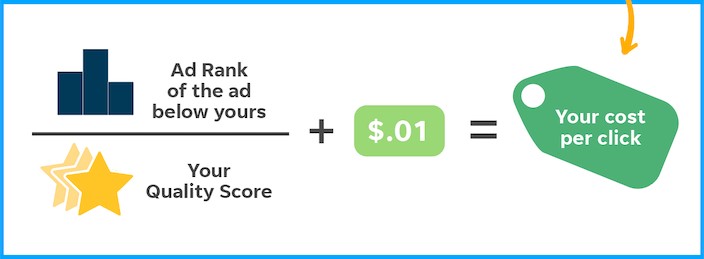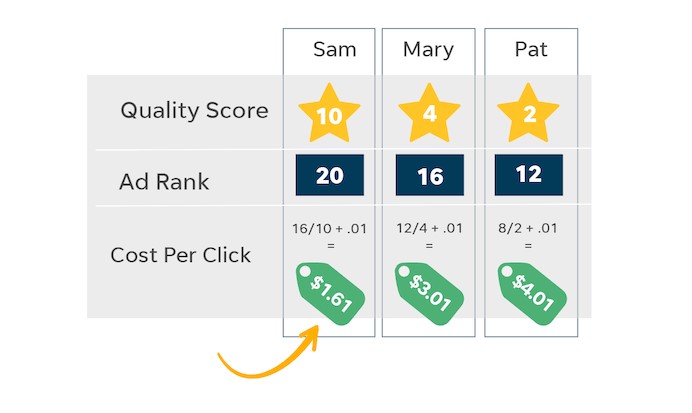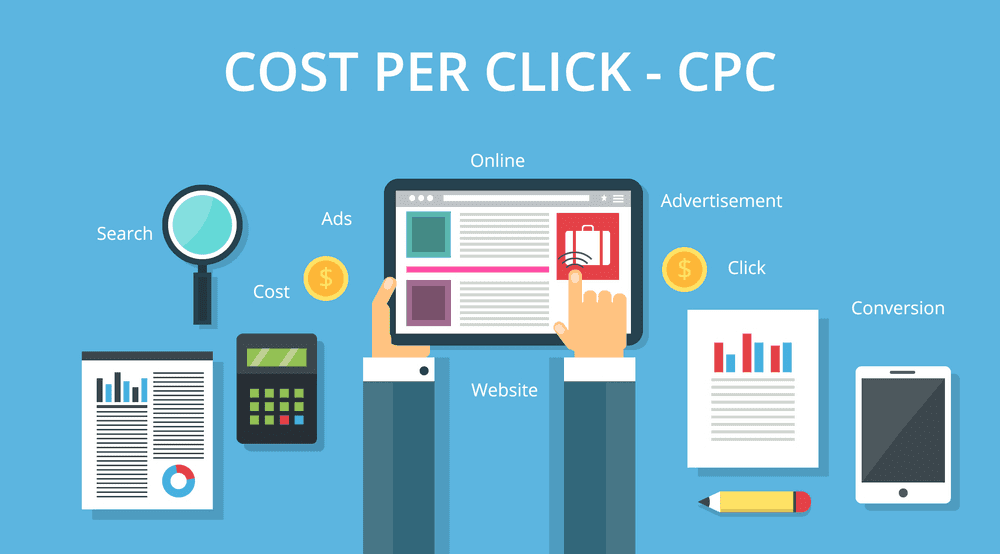Intro
When it comes to advertising on Google, understanding the “Google Ads Clicks cost” is crucial. This metric not only determines how much you’ll pay for every person who clicks on your ad, but it also plays a significant role in your overall ROI. However, calculating this cost can often feel like a daunting task, especially for those new to Google Ads. In this blog post, we’ll dive into the specifics of the cost of Google Ads clicks and break down the various factors that contribute to it. Plus, we’ll share some tips on how to optimize this cost for maximum success in your ad campaigns. Let’s crunch the numbers and demystify the cost of Google Ads clicks.
What is the Cost Per Click (CPC)?
Understanding the basics of Google Ads cost is essential for any advertiser looking to optimize their campaigns and achieve maximum ROI. When it comes to Google Ads, the cost of each click, also known as Cost Per Click (CPC), is a fundamental metric that determines how much you pay for every person who clicks on your ad. It’s impacted by factors like keyword competitiveness, your ad’s quality score, and your chosen targeting settings.
To optimize CPC effectively, prioritize relevant keywords that align with your ad objectives and target audience. By selecting high-quality keywords that have a lower level of competition, you can lower your CPC and increase the chances of attracting more clicks from interested users.
Additionally, optimizing your ad copy and landing pages can have a significant impact on your CPC. By creating compelling and relevant ad copy, you can improve your Quality Score, which can lower your CPC. Moreover, having well-designed, user-friendly landing pages can increase conversion rates, leading to a more cost-efficient CPC.
The Mathematical Approach: How to Calculate the Cost per Click
Understanding the mathematical approach to calculating the cost per click (CPC) in Google Ads is essential for any advertiser looking to optimize their campaigns. Understanding the CPC calculation empowers you to make informed decisions regarding your advertising budget and adapt your strategies for optimal ROI.
Google Ads Clicks cost
To calculate CPC, you simply divide the total cost of your ad campaign by the number of clicks it receives. You can express this using the following formula:
CPC = Total Cost / Total Clicks
For example, if your ad campaign costs $100 and receives 50 clicks, your CPC would be $2 ($100 / 50 = $2).
However, it’s important to note that this is a simplified calculation. In reality, Google Ads takes into account other factors such as Quality Score and ad rank to determine the actual CPC for each click. The Quality Score is a metric that measures the relevance and quality of your ads, keywords, and landing pages. A higher Quality Score can lead to a lower CPC.
CPC Optimizing
To optimize CPC, focus on improving your Quality Score by optimizing your keywords, ad copy, and landing pages. By using relevant keywords that align with your ad goals and target audience, you can increase your Quality Score and potentially lower your CPC. Additionally, continuously monitoring and analyzing your campaign performance will help you identify areas for improvement and make data-driven decisions to reduce your CPC.
Remember, optimizing CPC is an ongoing process. Regularly testing and refining your strategies will help you achieve the best possible results and ensure that you’re getting the most out of your advertising budget. So, dive into the numbers, experiment with different approaches, and find the sweet spot that maximizes your success in Google Ads.
How is Cost Per Click Calculated?
The formula for calculating CPC is relatively straightforward. To calculate your CPC, you divide the Ad Rank of the ad below yours by your Quality Score and add one cent. This formula ensures that your CPC is always less than or equal to your maximum bid:

Ad Rank is affected by your highest bid, Quality Score, and the ad rank threshold. The ad rank threshold is the minimum bid in the auction; if your bid falls below this threshold, your ad won’t be eligible to appear.
Strategies to Optimize Your Cost per Click
Now that we have a solid understanding of the basics of Google Ads cost and how to calculate the cost per click (CPC), it’s time to dive into strategies to optimize your CPC and get the most bang for your buck.
Monitor your keyword selection continuously
One effective strategy is to continuously monitor and refine your keyword selection. By regularly reviewing and updating your keywords based on their performance, you can ensure that you’re targeting the most relevant and high-quality keywords. This can lead to a higher Quality Score and ultimately lower your CPC.
Optimize your ad copy
Another important strategy is to regularly test and optimize your ad copy. Creating compelling and relevant ad copy can significantly improve your click-through rate (CTR), which can lower your CPC. Experiment with different messaging, headlines, and calls to action to see which variations resonate best with your target audience.

Optimize your landing pages
Additionally, optimizing your landing pages is crucial for lowering your CPC. A well-designed and user-friendly landing page can improve your conversion rate, which means more conversions for less spend. Ensure your landing page is highly relevant to your ad and offers a clear value proposition to the user.
Adjust the display of ads for the most effective times
Another effective strategy is to take advantage of Google’s ad scheduling feature. By analyzing data and identifying the most effective times and days for your ads to run, you can allocate your budget to those peak periods and optimize your CPC. This can assist in optimizing your return on investment and ensuring your ads display when your target audience is most likely to engage.
Common Misconceptions about Google Ads Clicks Cost
While understanding the basics of Google Ads cost and how to calculate the cost per click (CPC) is crucial, some common misconceptions can lead advertisers astray. Let’s debunk a few of these misconceptions and set the record straight.
Does a higher CPC mean better results?
One common misconception is that a higher CPC automatically means better results. While it may seem logical to assume that spending more on each click will yield better outcomes, this is not always the case. It’s important to focus on the quality of clicks rather than the quantity. A lower CPC with a high click-through rate (CTR) and conversion rate can be more valuable than a higher CPC with lower engagement and conversions.
Does higher bidding guarantee the top ad position?
Another misconception is that bidding the highest amount will guarantee the top ad position. While bidding higher can increase your chances of securing a top position, it’s not the sole determinant. Google Ads also takes into account factors such as Quality Score and ad relevance. A well-optimized ad with a high-quality Score can achieve a top position at a lower bid, making it important to focus on overall ad performance rather than just bidding high.
Additionally, many advertisers believe that broad-match keywords are the most effective in driving clicks. While broad match keywords can generate a wider reach, they can also attract irrelevant clicks that won’t convert. It’s crucial to strike a balance between broad and targeted keywords to ensure that your ads are reaching the right audience.
Is it necessary to show our ads 24/7?
Lastly, some advertisers think that running ads 24/7 will maximize their exposure and results. However, this may not always be the case. By analyzing your campaign data, you may find that certain days or times perform better than others. It’s important to optimize your ad schedule and allocate your budget to the periods when your target audience is most likely to engage with your ads.
By debunking these common misconceptions, advertisers can make more informed decisions and optimize their cost per click for maximum success in their Google Ads campaigns.
Factors Affecting Google Ads Clicks cost
Quality Score
Quality Score is a critical factor in determining your Ad Rank and ultimately your CPC. A score is assigned to each keyword in your ad auction, determined by its historical performance. Google calculates your Quality Score based on three metrics: expected clickthrough rate, ad relevance, and landing page experience.
A higher Quality Score indicates that your keywords perform well in the auction, leading to a better Ad Rank and lower CPC. To boost your Quality Score, focus on improving your clickthrough rates, creating relevant ads, and optimizing your landing pages to align with user search intent.
Ad Rank
Ad Rank is the metric that determines whether your ad is eligible to appear and in which position it will appear. It’s calculated using your current Quality Score and your designated maximum cost-per-click (CPC). The higher your Ad Rank, the better your ad’s position on the search engine results page.

Ads with the highest Ad Rank will feature in the Google Ads auction, potentially excluding lower-ranked ads. Factors like bid amount, Quality Score, and the context of the user’s search influence Ad Rank. Optimizing your Ad Rank can help you secure better positions for your ads while potentially reducing your CPC.
Ad Rank Threshold
The Ad Rank Threshold represents the minimum bid needed for your ad to become eligible for display. If your bid falls below the Ad Rank Threshold, your ad will not appear in the auction. The Ad Rank Threshold guarantees that only ads meeting a particular level of relevance and quality are shown to users.
It’s crucial to set your bids above the Ad Rank Threshold to increase the chances of your ad being eligible to appear in the auction. By doing so, you can ensure that your ad is visible to potential customers and improve your overall campaign performance.
Actual Cost Per Click
The actual cost per click is the amount you pay for each click on your ad. Various factors, including your Ad Rank, Quality Score, and your competitors’ bids, influence it. The formula for calculating the actual CPC is dividing the Ad Rank of the ad below yours by your Quality Score, plus one cent.
By understanding the factors that affect your actual CPC, you can strategically optimize your bids, improve your Quality Score, and potentially reduce the cost of your clicks. This optimization can lead to cost savings and improved ROI for your Google Ads campaigns.
Practical Examples: Real-Life Applications of Cost-per-Click Optimization
Now that we’ve covered the basics of Google Ads cost and how to calculate the cost per click (CPC), let’s dive into some real-life examples of how to optimize your CPC for maximum results.
Example 1
Let’s say you’re a local bakery running a Google Ads campaign to promote your new line of pastries. By carefully selecting relevant keywords such as “fresh pastries,” “local bakery,” and “delicious treats,” you can target users who are specifically searching for what you offer. By focusing on these targeted keywords, you can increase your Quality Score and potentially lower your CPC. Additionally, running ad scheduling analysis may reveal that your ads perform best during lunchtime when people are craving a sweet treat. By adjusting your ad schedule and allocating more budget during these peak periods, you can optimize your CPC and maximize your conversions.
Example 2
Imagine you’re a digital marketing agency specializing in social media management. You’ve been running a Google Ads campaign to attract new clients, but you’ve noticed that your CPC is higher than expected. By reviewing your keyword performance data, you realize that broader keywords like “marketing agency” are driving a lot of clicks, but few conversions. To optimize your CPC, you decide to focus on more specific and targeted keywords like “social media management agency” or “Facebook ad experts.” By honing in on your niche, you can reduce the number of irrelevant clicks and increase your chances of attracting potential clients who are more likely to convert. This targeted approach can lead to a higher Quality Score and a more cost-effective CPC.
Example 3
Let’s say you’re an e-commerce store selling athletic shoes. Your Google Ads campaign is performing well, but you want to take it to the next level and optimize your CPC. After analyzing your data, you notice that certain days of the week, like Fridays and Saturdays, drive the most conversions. Allocating a higher budget to these peak periods can optimize your CPC, ensuring your ads display when your target audience is most likely to engage and make purchases.
Additionally, you decide to leverage remarketing campaigns to target users who have already shown interest in your products. By creating tailored ads for these users and offering them exclusive discounts or promotions, you can increase the chances of conversion and lower your overall CPC.
Final Thoughts and Future Perspectives on Cost-per-Click Marketing
As we wrap up this discussion on the cost of Google Ads clicks, it’s clear that understanding and optimizing your CPC is crucial for a successful advertising campaign. By focusing on relevant keywords, improving your ad copy and landing pages, monitoring campaign performance, and utilizing ad scheduling and remarketing, you can maximize your ROI and achieve better results.
Looking ahead, it’s important to recognize that the digital advertising landscape is constantly evolving. Google Ads continues to introduce new features and updates, making it essential for advertisers to stay up to date with the latest trends and strategies. Additionally, as technology advances, new advertising platforms and channels may emerge, offering even more opportunities for cost-per-click marketing.
It’s also worth considering the potential impact of AI and machine learning on CPC optimization. As these technologies continue to develop, they may provide advertisers with even more precise targeting capabilities and automated bidding strategies, further enhancing the efficiency and effectiveness of cost-per-click marketing.
Conclusion
In summary, mastering the cost of Google Ads clicks is crucial for advertisers who want to maximize their ROI. A data-driven approach that factors in CPC specifics empowers them to make informed budgeting decisions and adjust strategies as necessary. A CPC-optimized campaign focuses on the most relevant keywords, ad copy, and landing pages while leveraging advanced features like ad scheduling and remarketing for the best results.
